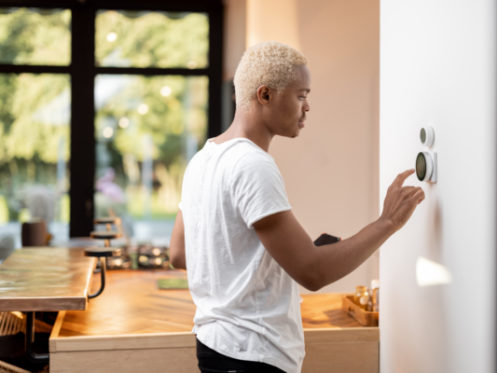Heat recovery ventilation, or HRV for short, is an efficient method for bringing fresh outdoor air inside your home to replace stale indoor air (without costing a lot of money). It does this by preventing heat from escaping during the winter or entering during the summer. Let’s take a closer look at the science behind HRVs to help you understand why your home in Omaha, NE, needs one.
Heat Exchange Principle
Heat exchange is the core concept of a heat recovery ventilation system. One airstream exits your house, carrying stale air with it. The other airstream enters your home, delivering fresh air with it. The heat exchanger is a specialized component of the unit that these two streams go through. Without physically mixing the two airstreams, it allows you to retain heat while removing the stuffy air.
Thermal Conduction
How is the transfer of heat from one airstream to another accomplished? The process is known as heat conduction. The scientific explanation for this is that heat moves from a hot object to a cold one as it passes through different materials. HRVs work by transferring heat from warm air to cold air as it flows past a thin wall. It’s similar to how your hand becomes warmer while holding a hot mug—the heat radiates off the surface and into your hand.
Air Pressure Balance
Keeping the air pressure balanced is also crucial to how HRVs function. The presence of air within a home without any corresponding expulsion causes a buildup of pressure. This can cause doors to slam or allow air to seep in via gaps. By regulating the airflow so that it is equal to the airflow out, HRVs maintain equilibrium. Your home’s HVAC system will run more efficiently thanks to this balanced flow.
Latent vs. Sensible Heat
There are two distinct types of heat. When you warm up your automobile, for example, you’re applying sensible heat, which raises the air temperature. Latent heat is related to moisture, such as the heat found in humid air. Since the first category is what HRV systems primarily handle, they are useful for heating or cooling outside air but aren’t great at removing moisture. (If you want that, you’d need an ERV—energy recovery ventilator—which handles both types of heat.)
Counterflow or Crossflow Air Paths
The airstreams can circulate in various patterns inside the heat exchanger. Two of the most typical are crossflow and counterflow. To maximize heat exchange, a counterflow configuration has the airstreams moving in opposing directions. The airstreams in a crossflow configuration are perpendicular to one another. Although it’s less complicated and less expensive than counterflow, it’s not as efficient. Typically, the installer gets to choose the airflow design; however, that might vary from one brand of heat recovery ventilator (HRV) to another. When you have us install an HRV, we’ll choose an airflow pattern that best suits your house and budget.
Improving Indoor Air Quality
When it comes to indoor air quality, HRVs are second to none. They remove stale, damp or dirty air and replace it with fresh air from outside. This is useful for getting rid of odors caused by things like cooking, pet dander, cleaning fumes and mold spores. It can also help with dust buildup and airborne allergens, which means fewer allergy symptoms.
Stack Effect and Ventilation Demand
Have you ever noticed that the rooms on the upper level of your home feel warmer during the winter? This occurs as a result of the stack effect, in which warmer air rises to the upper levels. The shift has the potential to upset the air circulation in your house. Fortunately, an HRV can help with this. They react to changes in airflow by drawing in more air when necessary.
Do All Homes Work Well With HRVs?
While an HRV system may not be the best fit for every house, it can still be beneficial for many. Because they exchange indoor and outdoor air while saving heat, they tend to work best in homes that have tight insulation and limited natural airflow. A lot of homes with cold winters also find them useful because of the energy savings. If your home has high humidity levels, you may want to consider an ERV instead of an HRV. Speaking with one of our HVAC experts is the best way to determine whether you need an HRV or another type of ventilation system.
We help homeowners in Omaha with everything from HRVs to heat pumps to geothermal systems and more. Our installation support is paramount to achieving the best comfort and energy savings possible. Contact Xtreme Heating & Cooling LLC now to access professional HVAC services in Omaha.
